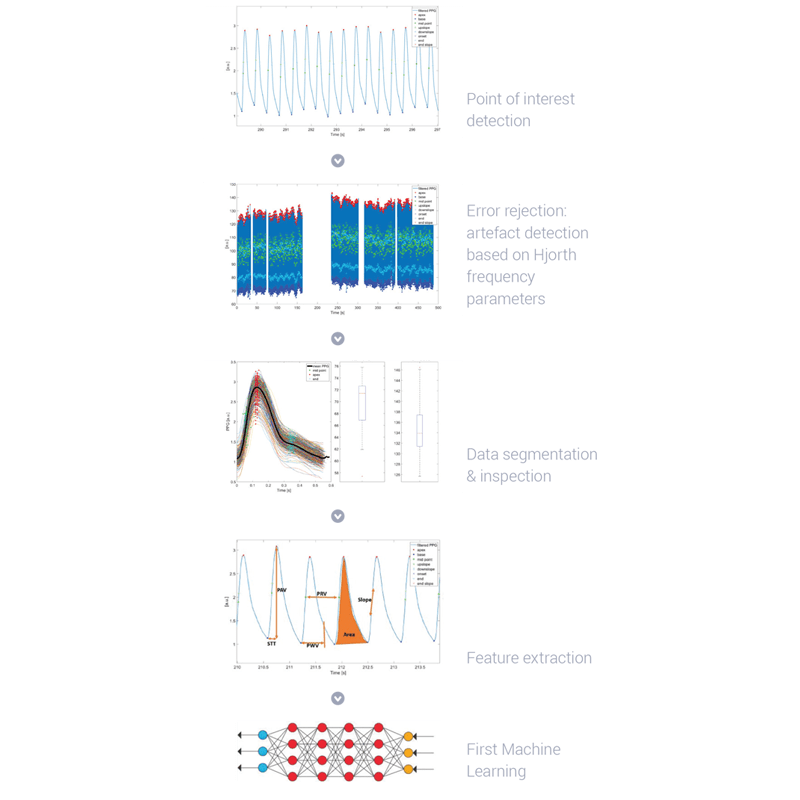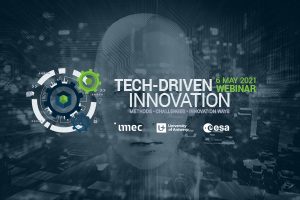After the dot.com bubble in the early 2000’s, a sigh of disillusionment propagated throughout the world. After all, the Internet was not the revolutionary technology putting the business world upside-down, nor a source of limitless wealth. It was just another hype. Business writers and academia pointed out that it had been wrong to think that existing rules of economics did no longer apply and that an old-fashioned, solid business model was still the basis for success. The World Wide Web was an interesting novelty, a promising opportunity, but not a revolution.
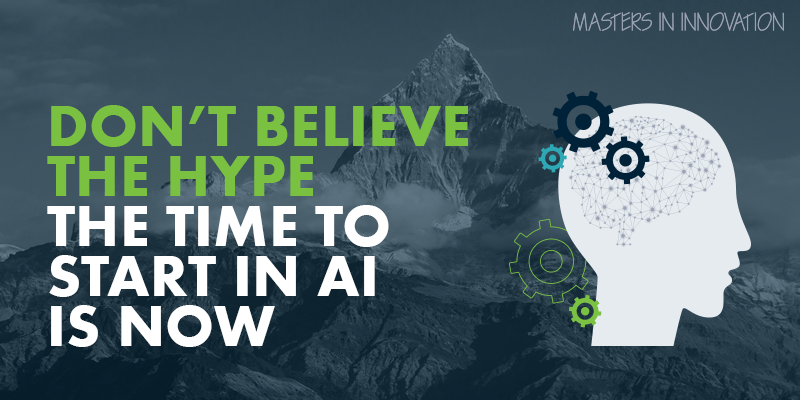
Don’t believe the hype: the time to start in AI is now
15 years later, it’s clear that this insight was as naive and shortsighted as the bubble itself. Not only did the Internet disrupt the business world, it fundamentally changed our lives and our entire society, from the way we buy our appliances and groceries, consume media and inform ourselves, to the way we communicate and socialize with friends and family. We book our holidays online, based on online reviews, we no longer buy physical media but subscriptions, we’re afraid social media engineering will influence national elections and the first ‘Tinder babies’ already walk and talk … New businesses have taken over the world (Google, Facebook, Alibaba, Amazon), while incumbents have invested billions to adapt or re-invent themselves in order to survive. The retail, media and travel sectors have become dark and telling case studies about the inability of organizations to change. Looking back, it seems that, collectively, we overhyped the Internet on the short term, but gravely underestimated its impact on the long term.
Of course, it is easier to criticize in hindsight. However, remarkably, it was not the first time such a ‘double estimation error’ occurred. It has happened several times before. In fact, this phenomenon even has a name: Amara’s Law, after the Stanford computer scientist and futurist Roy Amara , who coined following ‘law’ somewhere in the 60’s or 70’s, long before the Internet (as we know it) was conceived.
We tend to overestimate the effect of a technology in the short run and underestimate the effect in the long run.
Amara’s law has been applicable to the adoption of several world-changing technologies in the past, such as the personal computer, the automobile and the steam locomotive. It is also the basis for Gartner’s Hype Cycle , applying it to upcoming technologies, such as the human genome project, crypto-currencies, autonomous vehicles, VR and so on.
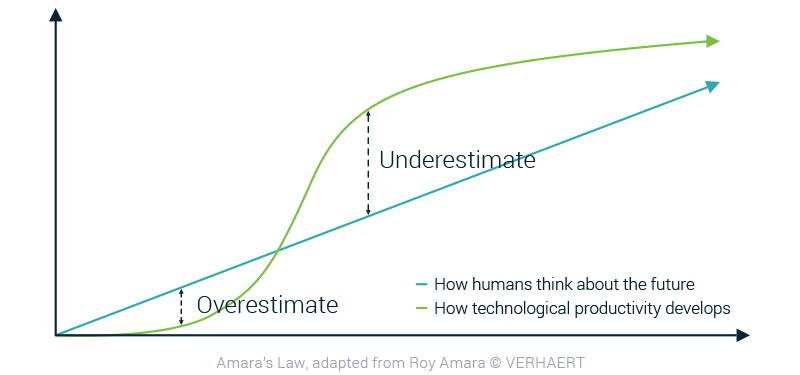
Amara’s Law is also applicable to AI, which is why our people from AILAb at Verhaert think it’s time to start in AI right now.
Telling that Artificial Intelligence and Machine Learning are hyped, is probably an understatement. Dedicated conventions are fully booked, investments and subsidies are rising and the general public is overwhelmed by spectacular cases, Utopian visions and doom scenarios, in which general AIs are ruling the world. In fact, to be ahead of the curve, practitioners already predict ‘AI Winter’: the burst of the AI bubble, after it will become clear that expectations have risen too steep.
They might be right. AI and Machine Learning are not new. Researchers have been developing algorithms and applications since the 1950’s. The phenomenal rise in computing power and suitable data over the last decades has enabled using Machine Learning in real use cases, with spectacular results. This has been fueling expectations. However, even though these applications are very advanced, their functionality is still narrow and they require enormous efforts to make them work, prohibiting broad adoption (data gathering and cleaning, labeling etc.). When everyone will become aware of these difficulties and requirements, the hype will probably fade and interest in AI will drop.
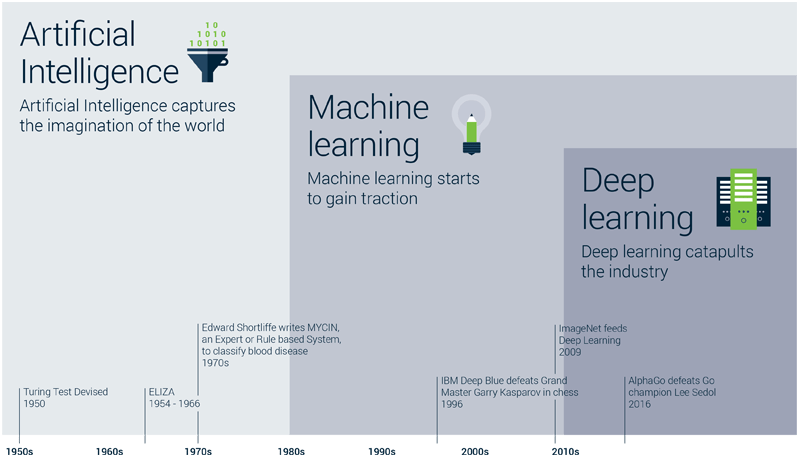
And that’s exactly why the time to start in AI is now. AI and Machine Learning have enormous potential, as demonstrated by these current applications. So we don’t know how or when it will drastically change our society, but the dot.com bubble and Amara’s Law teach us that, eventually, it will, on a scale we cannot imagine. Therefore, we should ask ourselves where we want to be when AI starts changing the world and act now to get there.
For example: at the moment, 2 major problems inhibiting the adoption of AI in organizations are the availability of sufficient qualitative data and the ability to organize for AI, building the right capabilities (as also witnessed in current digitization projects). These problems cannot be fixed overnight, they require long term vision and planning. Whether your future application will be a smart new product with built-in AI or an optimized internal process, the time is now to learn about the technology, to formulate an AI vision and to start developing, building the necessary knowledge and organizational capabilities, laying the groundworks to make future AI projects thrive.
The hype is still ongoing. In Flanders, €30 million will be made available yearly to boost AI R&D projects. The Netherlands and Finland are starting online tutorials and courses to convert people’s skills. China invests 2 billion USD in an AI Research park. Open source tools and databases are becoming widely available for prototyping, commercial packages and platforms are powerful and versatile enough to build a myriad of applications. Let us use the momentum to start exploring and developing, to build a smart future together. Only this way you can make sure that in 15 years, the AI story of your company will be a pleasant case study to tell.
The Verhaert AILab
Verhaert Masters in Innovation provides Artificial Intelligence development and consultancy services. The AILab combines deep knowledge of AI technology with a system engineering approach. Starting from an AI idea or vision, we bring AI down to Earth with our concrete ideation approach, building rapid prototypes and demonstrators. We also support companies in creating and refining a powerful and realistic AI product vision.
What sets us apart is our design and engineering DNA and experience. We understand that algorithms don’t just live in a box, but need to be integrated with the users and other technologies. We understand how sensors generate data and we are able to assess its quality.
Current AI technology maturity falls in-between applied research and application specific product development. In the coming years, the available application specific AI-libraries and platforms will grow rapidly, enabling fast prototyping for many specific applications. Without these specific libraries and platforms, a data-only driven approach could still be unfeasible. Domain specific system engineering and data expert knowledge can be a way to overcome this hurdle. A Verhaert multidisciplinary team can help to increase the chances of success of an AI project, by looking for the right data and the right spot to capture it, through deep technical understanding of the problem, the ins and outs of the transducer and the physical phenomenon that is measured.
Verhaert AI projects
Safesens
Safesens was a European research project to improve safety and security of buildings and humans during a fire. Verhaert was one of the partners to develop embedded sensor technologies for reliable early fire detection.
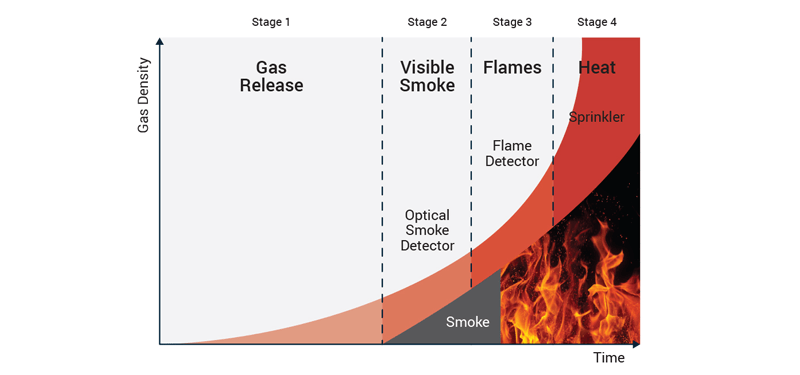
The objectives of the Safesens project were fourfold:
- Early fire detection combined with the notification of type gases.
- Monitoring the health of firemen (with a smart watch) and their location in the building.
- Detecting everybody who is present in the building, during and after the evacuation.
- Estimate the remaining time before the next fire stage arrives for each location (f.e. for each sensor or room), to help prioritizing firefighting actions.
The Verhaert AI team developed algorithms to achieve objective 1 and 4 ie for early fire detection and prediction of the stages in the fire cycle and prediction of the speed of change of the fire from stage to stage. This was achieved using principal component analysis for dimensionality reduction and support vector machines for classification of the stage using a set of gas sensor (VOC, CO2, CO), smoke and flame detectors and cameras.

eWatch
As part of another European research project, Verhaert is currently developing an AI application for eWatch to estimate blood pressure, based on a smart watch raw PPG signal. A PPG (often embedded in smart watches – look for the green LED) detects the changes in blood volume in the skin, as the heart pumps around blood, enabling heart rate monitoring. As PPG and blood pressure waves are correlated, the same PPG signal could also be used to estimate blood pressure. However, a PPG signal is very noisy (due to movements of the wrist, movements of the smart watch on the wrist, sun rays entering the skin, skin movements, muscle contractions and lymph flow), and the blood pressure is hidden somewhere in all that noise.

Using a convolutional neural network, the AI Lab is searching for a reliable blood pressure pattern in PPG data. It recently got a clearance from the ethical committee to start clinical trials. Embedding blood pressure measurement in a wearable will allow for helping hypertension and diabetic patients in their daily routine with instant feedback on blood pressure levels, long term follow-up and automatic emergency alarms.
